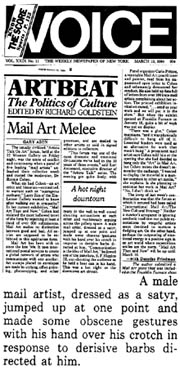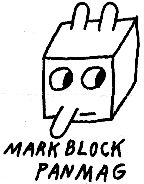
 |
Franklin Furnace Fracas by Mark Bloch On two consecutive Fridays, February 17th and 24th of 1984, two historic Artists Talk on Art mail art debates took place at the Wooster Street Gallery in Soho, New York City. The art critic Dr. Ronny Cohen was taken to task for her missteps with the Franklin Furnace mail art show. Cohen was guilty of violating the "unwritten rules of mail art" that she promised to follow in the invitation. At the second panel, mail artists read a manifesto, a shouting match ensued and Cohen abruptly took her leave from the "mail art melee," (as it was described in the Village Voice) which exploded into chaos. A careful reading of the talks' transcripts that John P. Jacob created in his magazine HYPE, reveal in retrospect that it was me, costumed as Pan and more more irreverent than usual, that pushed Dr. Cohen (and the previous week, critic Robert Morgan) over the edge. I was the one dressed as a satyr (see above), distributing my PANMAGs to the audience and perhaps a little too charged up on adrenalin for my own good. However this series of events was the result of a cumulative effect that had been building for weeks and I was by no means the only vociferous one. In retrospect, this event was a "perfect storm" that pitted "art" against the "art world" and that needed to happen, both for the mail art network and the art world at large. Mail artists finally got a chance in a public forum to espouse their philosophy that had been building for decades: that everyone is potentially an artist and everything is potentially art; that it is the viewer who must decide what is of value. One of the "unwritten rules" was that everything received for a mail art show is displayed. There is no jury in a mail art show; no arbitors of taste to decide what is of quality and what is not. The viewers of the show make that distinction for themselves. Cohen sent out an invitation stating the the Franklin Furnace mail art show would follow this tradition. The "entries" poured in. The "perfect storm" occurred in the sense that mail art had been growing for years and was perhaps peaking at this time. The network of mail art practitioners was very large and growing. Participants all over the world in some fifty countries were passionate about the activity. Carlo Pittore, living in New York and a lifetime fighter for the rights of artists, was one of the people featured in an article Dr. Ronny Cohen wrote in Art News about mail art. Next, he arranged for the two consecutive weeks of panel discussions at the Artists Talk on Art series, a fixture on the downtown art scene where a group of artists talk about an issue in front of an audience at a local gallery. It continues to this day and remains a wonderful opportunity for artists and art lovers alike to learn about art and explore specific topics. In this case, the stage was set by Pittore for a modern day Shootout at the O.K. Coral. At that point, however, Carlo was simply working to make mail art famous. The panels, the Art News article and the Franklin Furnace exhibition all looked like they would have a positive outcome for all concerned. After over two decades of intense activity, the mail art network finally seemed to be getting some much-deserved attention in the art media, its first in years. Dr. Cohen, an open-minded and intelligent young critic, and the Franklin Furnace, an experimental institution which could be said to have at least partly grown out of the fertile earth of the Eternal Network, were overwhelmed when the responses to their call to the "Mail Art: Then and Now" show never stopped arriving. Dozens of pieces rolled in day after day from all over the planet. What happened next was the tipping point. Cohen made the decision not to display everything. There was simply too much art and the space was limited. When pressed on this point by Pittore and others, she elected to make all the entries available by putting the overflow into either notebooks or cardboard boxes on the floor. This was too little, too late and proved to be her fatal mistake. All this corresponded with the approaching Artist Talk on Art panels. She was to be the moderator of the second one. The first week featured art writer Robert Morgan. The first week was wild and crazy with the issue of mail art "jurying" or "censorship" being raised. I was a young rebel in those days, not used to dealing with critics and naturally averse to any form of authority. As a panel member, dressed as Pan the Goat God, I cracked jokes and did my best to undermine the proceedings. I was joined verbally on stage and occasionally by members of the unruly and irreverent audience in this endeavor. But as I remember it, while insolent, the evening ended fairly calmly with a presentation of the views and a laying out of the turf that would be trampled the following Friday. All week long Pittore composed his manifestos and collected endorsements from all over the world for his actions. The show had opened in January, giving Carlo and the Network (called by some of us then, "The N-tity") enough time to have worked our collective indignation and righteous anger into a lather by this late February hiatus between the two panel discussions. Pittore, characteristically up in arms, was an inspired leader gunning for "justice" rallying his troops like General Sherman marching to the sea. Thus was the stage was set for total bedlam. If I remember correctly, the previous week's moderator Morgan sat in the audience this second week, (as would I, again dressed as a satyr and again distributing a new issue of PANMAG, this one featuring the list of names Carlo had collected) and so would Pittore, strangely silent. I suppose he knew his work was done. Now Dr. Cohen was the moderator. On the panel that second week was Chuck Welch, known as the Cracker Jack Kid, who was selected by the mail artists to interrupt the proceedings at a choice moment and read a statement to de-throne Cohen from her position as moderator. When he did so all hell broke loose. Ed Higgins, internationally known for his alleged love of beer (I used to call him the New York "Coors"-spondence School) and a producer of artist postage stamps, also on the panel, was quite hopped up on hops and gave new meaning to the phrase "bully pulpit." Before, during, and after Cracker Jack's statement, he bellowed insults, accusations and non-sequitors enhancing the room's general atmosphere of insanity. In the end, Cohen did step down and left the proceedings with a friend and defender named Zim, the proprietor of a local gallery. He got up and left as Dr. Cohen was saying something to the effect of "Have fun, boys." While her defeat was a wonderful triumph for the ideals of mail art and a rare instance of artists fighting back against the art establishment, I have said, since then, that part of me regrets the divisive direction and mean-spirited tone our actions took. I believe they hurt the mail art network at a critical (pun intended) juncture. "I'm sick of the mail art Shoot-yourself-in-the-foot School," I once told Ray Johnson in reference to another incident. "You didn't learn that in my School," Johnson replied without hesitation. It would appear that despite much evidence to the contrary, the mail art network, like Johnson himself, needn't let an apparent lack of mainstream acceptance be inextricably linked to self-sabotage. No matter what one's point of view on this and other issues, one must agree that it is ironic that at the precise moment an established art writer and critic was stepping forward to assist us in our quest to be accepted as a "legitimate" art form, the mail art network erupted in chaos and ultimately said, "We will have no such thing." I suppose after years of being our own publishers, critics and curators, a purist would say we didn't need to be "rubber stamped" (pun intended) by any Art Mafia to achieve "legitimacy." But one has to admit that a little attention from an ordained art world bishop or priest is always a welcome thing for an artist, whether it is admitted or not. Finally, isn't is also ironic that an angry mob of irate men found ourselves in the position of ferociously taking the wind out of the sails of a soft-spoken female who was uniquely situated to help us in our attempts to transcend cultural invisibility? A letter he wrote to me a couple of weeks later revealed that this final irony was not lost on Ray Johnson, founder of the New York Correspondence School and the most well-known proponent of correspondence as an art form. Furthermore, on January 7, 1992, I spoke to Ray Johnson on the phone about a different woman who did help him in a different mail art show, some fifteen years before the Franklin Furnace fiasco. We were discussing a recent text published by Clive Philpot of the Museum of Modern Art. Here are some quotes from Ray: "Oh yeah that reminds me- there was one thing Clive said I didn't agree with. The dictim that 'Ray Johnson said that everything must be shown.' I don't happen to agree with that. It was about the dogmas of the mail art shows. That was a policy that was determined at my Whitney Museum show by Marcia Tucker, not me. I didn't want it to be seen. I said it would just be put in a corner. She thought it should be educational. I thought nothing should be seen. I looked at it all in the basement. What did I care about the city of New York and the public? Marcia Tucker said, 'People should be able to see it. It's a public museum.' I don't agree. "For accuracy's sake, Marcia Tucker should be credited with the policy of the New York Correspondence School. She took over as institution. I was merely the person inviting 116 people to be in that show. It said 'please send...' No explanation that they'd be exhibited, that they'd be catalogued. They just sent it." I have always questioned why a medium or a movement like mail art, with no rules, should have a bunch of "unwritten rules." But either way, Dr. Ronny Cohen wrote them down on the invitation and this historic event was the result.
Primary Documents
Timeline
|